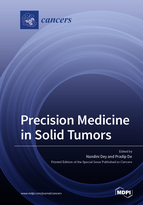Precision Medicine in Solid Tumors
A special issue of Cancers (ISSN 2072-6694). This special issue belongs to the section "Cancer Therapy".
Deadline for manuscript submissions: closed (31 August 2021) | Viewed by 50718
Special Issue Editors
Interests: personalized precision medicine; pathway targeted drugs; tumor cell signaling
Special Issues, Collections and Topics in MDPI journals
2. Consultant, VieCure, Greenwood Village, CO, USA
Interests: genomics-driven treatment approach in n-of-1 format; tailored immune-therapy; PI3K-mTOR pathway
Special Issues, Collections and Topics in MDPI journals
Special Issue Information
Dear Colleagues,
Precision medicine and personalized medicine are terms of the future of oncology. The conception and evolution of these two terms in translational research, as well as in successful clinical care in oncology, owes heavily to the technological revolution, which provided comprehensive genomic data in the post-human genome project era. While we are approaching a more optimistic future of clinical medicine empowered with the knowledge of “exactly targeting” the signaling in the tumor cell that caused its oncogenic transformation (Precision) in a particular patient in a specific time point (Personalised), we are still far from the finish line. The challenges are the enormity and legality of the data and the limited translation of knowledge to patient outcomes. Have we reached the saturation point for finding a new effective-target in oncology? Can immune‐target(s) work synergistically with molecularly-driven targets in achieving a comparatively favorable outcome in clinical trials? Nonetheless, we have enthusiasm and perseverance from the research and clinical communities. The book entitled “Precision Medicine in Solid Tumors” will fulfill the expectation of thoughtful readers in translational research and clinical research towards the understanding and use of personalized medicine and precision medicine; how personalized medicine and precision medicine overlap synergistically; and how personalized medicine and precision medicine are complementary to each other at the bench and the bedside.
Dr. Nandini Dey, MS., Ph.D.
Dr. Pradip De, MS., Ph.D.
Guest Editors
Manuscript Submission Information
Manuscripts should be submitted online at www.mdpi.com by registering and logging in to this website. Once you are registered, click here to go to the submission form. Manuscripts can be submitted until the deadline. All submissions that pass pre-check are peer-reviewed. Accepted papers will be published continuously in the journal (as soon as accepted) and will be listed together on the special issue website. Research articles, review articles as well as short communications are invited. For planned papers, a title and short abstract (about 100 words) can be sent to the Editorial Office for announcement on this website.
Submitted manuscripts should not have been published previously, nor be under consideration for publication elsewhere (except conference proceedings papers). All manuscripts are thoroughly refereed through a single-blind peer-review process. A guide for authors and other relevant information for submission of manuscripts is available on the Instructions for Authors page. Cancers is an international peer-reviewed open access semimonthly journal published by MDPI.
Please visit the Instructions for Authors page before submitting a manuscript. The Article Processing Charge (APC) for publication in this open access journal is 2900 CHF (Swiss Francs). Submitted papers should be well formatted and use good English. Authors may use MDPI's English editing service prior to publication or during author revisions.
Keywords
- solid tumors
- RTKs
- PI3K-mTOR pathway
- RAS-MAPK pathway
- DNA damage repair pathway
- sequencing-based drug matching
- personalized precision oncology







